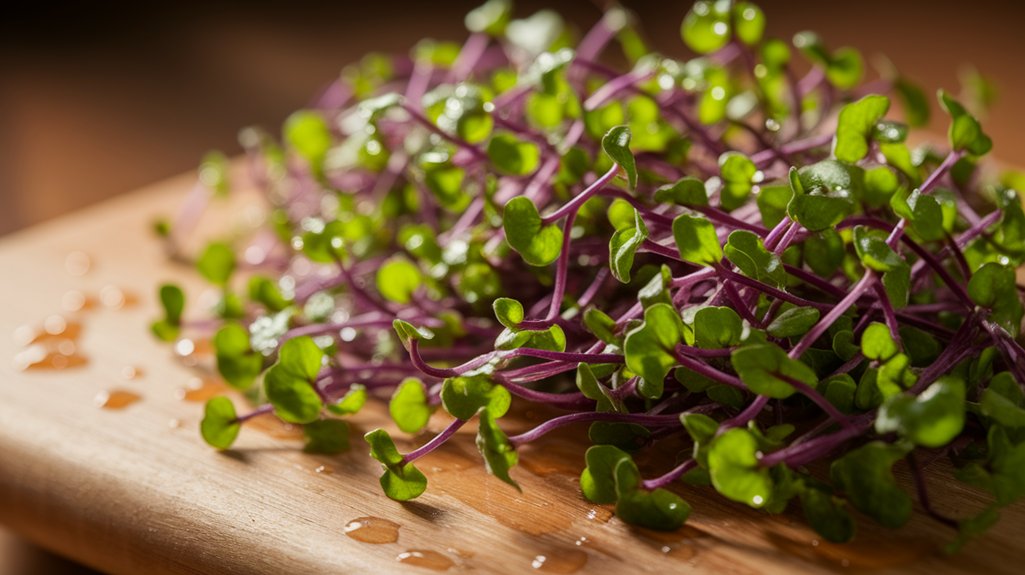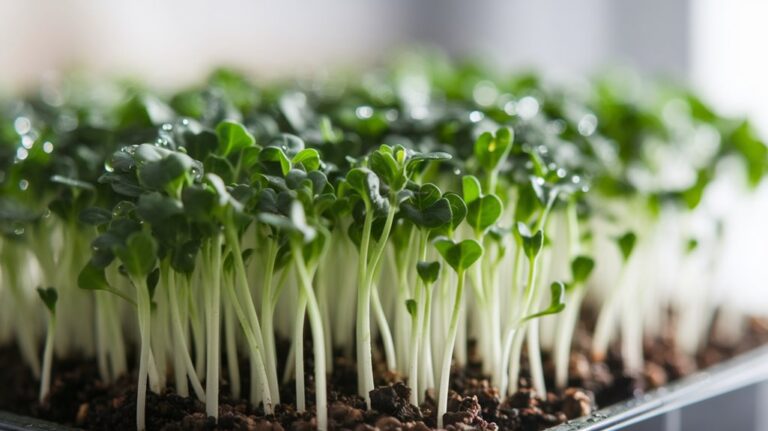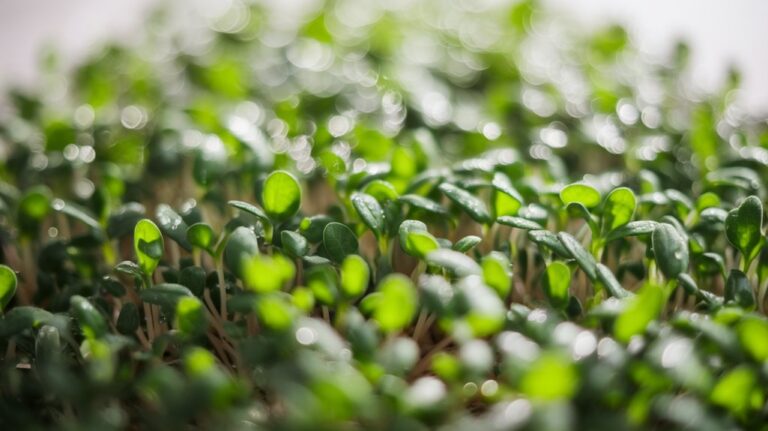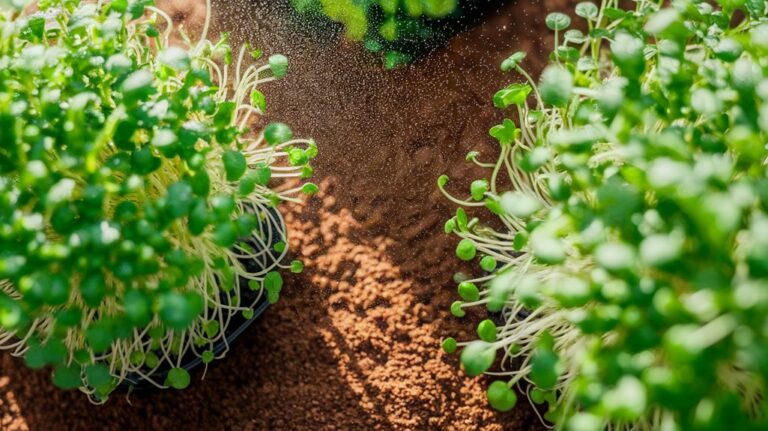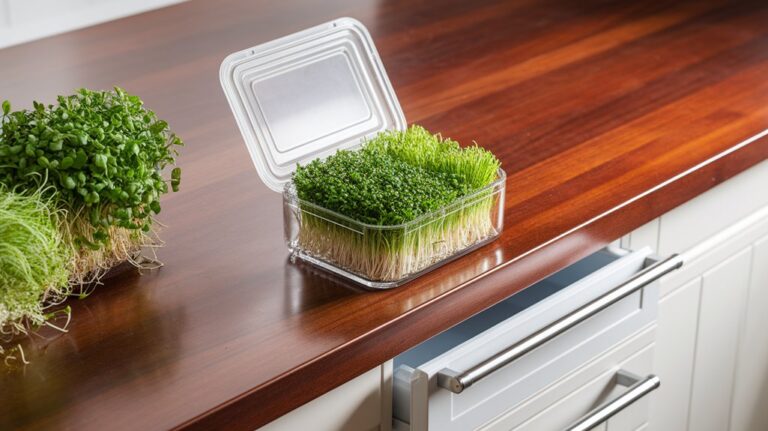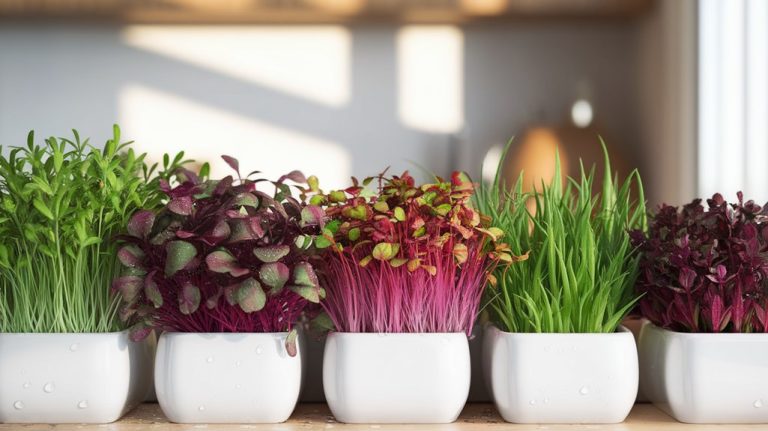MUSTARD Microgreens: Bold Flavor for Bold Dishes
I love incorporating mustard microgreens into my dishes for their bold, peppery flavor. They add a zesty kick that’s reminiscent of mature mustard greens, making meals vibrant and exciting. Whether I’m tossing them in a salad or using them to elevate a sandwich, their lively crunch always impresses. Plus, they’re packed with vitamins and antioxidants, boosting my nutrition. If you stick around, I’ll share more creative ways to use these delicious microgreens in your cooking adventures.
Key Takeaways
- Mustard microgreens deliver a bold, peppery flavor that enhances the taste of various dishes.
- Their vibrant green leaves add visual appeal, making meals more attractive.
- Rich in nutrients like Vitamin C, K, and antioxidants, they contribute to a healthy diet.
- Perfect for salads, soups, sandwiches, and sauces, they offer versatility in culinary applications.
- Harvested in just 5-10 days, they are easy to grow at home for fresh flavor.
Understanding Mustard Microgreens: A Flavor Profile

When I first encountered mustard microgreens, I was captivated by their bold, peppery flavor that instantly adds a kick to any dish. These tiny greens pack a punch, with a taste reminiscent of their mature counterparts—zesty and slightly spicy.
As I began experimenting, I discovered that their vibrant green leaves not only enhance the visual appeal of my meals but also elevate the overall flavor profile. Whether sprinkled atop a salad, blended into a smoothie, or used as a garnish for soups, mustard microgreens bring a lively crunch that contrasts beautifully with creamy or rich textures.
I love how versatile they are, and I can’t help but incorporate them into my cooking, making every meal a delicious adventure.
Nutritional Benefits of Mustard Microgreens
Although I often focus on the flavor when using mustard microgreens, their nutritional benefits are equally impressive. These tiny greens are packed with vitamins and minerals that can elevate any dish. Just a handful of mustard microgreens can provide a boost to your health.
| Nutrient | Amount per 100g |
|---|---|
| Vitamin C | 60 mg |
| Vitamin K | 280 mcg |
| Calcium | 150 mg |
| Iron | 1.5 mg |
| Antioxidants | High |
Incorporating them into your meals means you’re not only enhancing taste but also enriching your diet. Their impressive nutrient profile makes them a powerhouse addition to salads, sandwiches, and more. Enjoy the benefits while savoring that bold flavor!
How to Grow Mustard Microgreens at Home
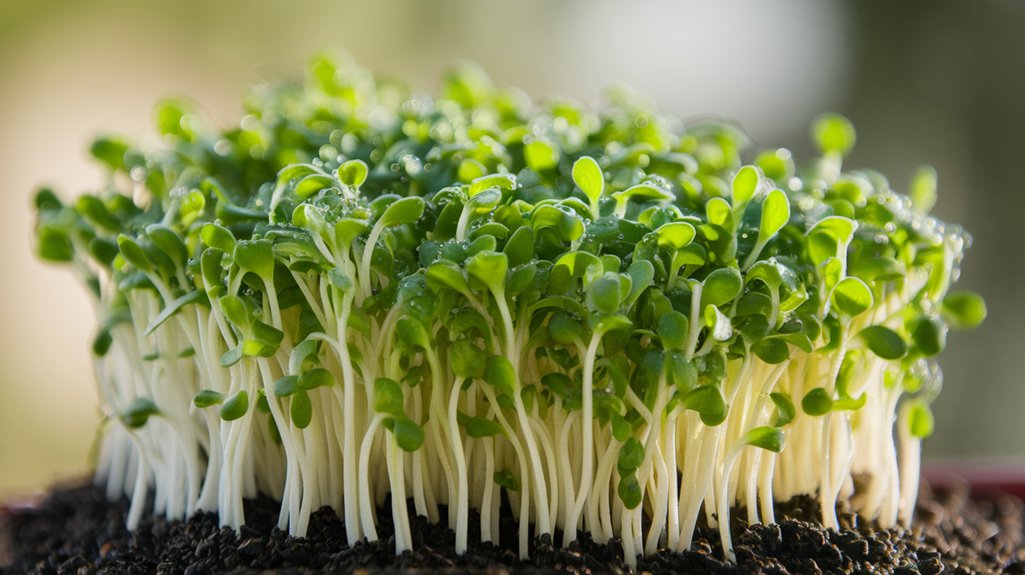
Growing mustard microgreens at home is a rewarding experience that can elevate your culinary creations while providing fresh, nutrient-rich greens at your fingertips.
To start, gather some mustard seeds, a shallow container, and potting soil. Fill the container with soil, leaving about an inch of space at the top. Scatter the seeds evenly across the surface, then lightly press them into the soil. Mist the soil with water and cover the container with a lid or plastic wrap to create humidity.
Place it in a warm, bright spot, ensuring it gets indirect sunlight. In about 5-10 days, you’ll see tiny greens sprouting. Once they reach 2 inches tall, it’s time to harvest and enjoy the bold flavor they bring to your dishes!
Creative Ways to Use Mustard Microgreens in Your Cooking
While exploring new flavors in my cooking, I’ve discovered that mustard microgreens are a game-changer. Their peppery bite adds an exciting twist to various dishes.
I love tossing them into salads for an extra crunch or using them as a vibrant garnish atop creamy soups. They elevate sandwiches and wraps, providing a zesty kick that complements meats and cheeses beautifully.
When I’m feeling adventurous, I blend them into smooth pestos or sauces for a bold flavor infusion. Even simple scrambled eggs transform into something special with a sprinkle of these microgreens.
The versatility is endless, and their striking green color makes any plate visually appealing. Trust me, once you try them, you’ll wonder how you ever cooked without them!
Recipes Featuring Mustard Microgreens for Every Meal

When I’m looking to add a burst of flavor to my meals, mustard microgreens always come to mind.
For breakfast, I sprinkle them on avocado toast, pairing their peppery taste with creamy goodness.
At lunch, I toss them into salads for an exciting crunch and vibrant color.
For dinner, I love incorporating mustard microgreens into stir-fries, where they infuse dishes with a zesty kick.
Even in pasta, they elevate simple sauces, adding complexity.
For a unique twist, I blend them into pesto, combining their bold flavor with nuts and cheese.
Mustard microgreens are my secret weapon, turning every meal into a culinary adventure.
They’re easy to use and elevate any dish with their distinct taste!
Frequently Asked Questions
Are Mustard Microgreens Suitable for People With Mustard Allergies?
I’ve often wondered about mustard microgreens and whether they’re safe for those with mustard allergies.
Unfortunately, they’re not suitable for anyone allergic to mustard. Since microgreens come from the same plant family, they can trigger the same allergic reactions.
I recommend avoiding them if you have a mustard allergy. It’s always wise to consult with a healthcare professional before trying new foods, especially if you have known allergies.
Stay safe and informed!
How Long Can I Store Harvested Mustard Microgreens?
I’ve found that harvested mustard microgreens can be stored in the fridge for about five to seven days.
To keep them fresh, I place them in a damp paper towel and store them in a breathable container. This helps maintain their crispness and flavor.
However, I always recommend checking for any signs of wilting or spoilage before using them. Freshness really makes a difference in taste!
Can I Use Mustard Microgreens in Smoothies?
Absolutely, I love using mustard microgreens in smoothies! Their peppery flavor adds a delightful kick that transforms a regular smoothie into something special.
I usually blend them with fruits like bananas or berries to balance the taste. Just a handful can elevate the nutritional value too, packing in vitamins and minerals.
If you’re looking for a unique twist, give it a try—you might be surprised by how much you enjoy it!
Do Mustard Microgreens Require Special Lighting Conditions?
Absolutely, mustard microgreens thrive with the right lighting!
I’ve found they prefer bright, indirect sunlight for about 12-16 hours a day. If you’re growing them indoors, using grow lights can really boost their growth.
I usually position them a couple of inches away from the light source to prevent burning.
Are There Different Varieties of Mustard Microgreens Available?
Absolutely, there are several varieties of mustard microgreens that I’ve grown and enjoyed.
Each type brings its own unique flavor profile, ranging from spicy to slightly sweet. Some popular varieties include Brassica juncea, which has a robust, peppery taste, and the milder Brassica alba.
I love experimenting with these different types in my dishes, as they add vibrant colors and exciting flavors. It’s definitely worth exploring the variety that suits your palate best!
Conclusion
Incorporating mustard microgreens into my meals has truly transformed my cooking. Their bold flavor adds a delightful kick, elevating even the simplest dishes. Plus, knowing I’m reaping their nutritional benefits makes every bite even more satisfying. Whether I’m tossing them in a salad or using them as a garnish, these vibrant greens never fail to impress. I encourage you to explore the world of mustard microgreens; you’ll find they’re an exciting ingredient that can enhance any culinary creation!

